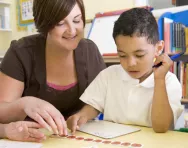The SEN code of practice 2014: what it means for your child

Navigating the special educational needs (SEN) system can be a minefield, and it’s not always easy to work out what sort of support your child needs, or to get it put in place.
Starting in 2014, the SEN system was completely overhauled. The Government intends that this will make it easier and faster for children to get the help they need – but getting used to the new practices might well seem confusing, especially if you’re used to the old system.


Boost Your Child's English & Maths!
- Weekly programme for each school year
- Worksheets sent direct to your inbox
- Keeps your child's learning on track
We outline the main changes.
What is a special educational need?
The 2014 SEN or SEND code of practice separates SEN into four areas:
- Communicating and interacting
- Cognition and learning
- Social, emotional and mental health difficulties
- Sensory and/or physical needs
Many children with SEN also have a disability – a physical or mental impairment which has a long-term and substantial adverse effect on their ability to carry out normal day-to-day activities. These include physical impairments like mobility problems, and ongoing health conditions like asthma or diabetes.
SEN are often first detected by a child’s school, who must contact you to discuss their concerns and tell you if they’re making any special provisions for your child. If you’re worried that your child may have SEN, you can speak to the school, who will discuss the issues with you and tell you what happens next.
The new code of practice: SEN support
Previously, children whose progress was causing concern may have been put on a programme called School Action or School Action Plus, where the teachers, special educational needs coordinator (SENCO), parents and outside agencies like educational psychologists put in place a school-based plan to support their learning.
School Action and School Action Plus have now been replaced by a system called SEN support. There are four stages to SEN support:
- Assess Your child’s needs must be assessed so they can get the right support. This process should involve parents, teachers, and potentially experts such as an educational psychologist or health professional.
- Plan The school, with your input, will agree on how they intend your child to benefit from the support that is put in place.
- Do The school will put the support in place. This is likely to involve your child’s teacher, the SENCO and any support staff or specialist teaching staff who will work with your child or be involved with tracking their progress.
- Review A date for reviewing your child’s support should be agreed at the time of making the plan. You and your child’s teachers will decide together whether the support is having the desired impact and what, if any, changes should be made.
The new code of practice: Educational, Health and Care needs assessments and plans
Under the previous system, children with more complex needs than could be met by the school alone underwent a Statutory Assessment, which in some cases led to a Statement of Special Educational Needs. This lasted until the child turned 16.
Statutory Assessments and Statements have now been replaced by Educational, Health and Care (EHC) needs assessments and plans. This is a simpler assessment process covering young people from birth to 25 years of age (in full-time education). The EHC plan is a legal document that sets out your child’s education, health and social care needs in one place.
You, or anyone at your child’s school, can ask the local authority (LA) for an EHC needs assessment. The LA has six weeks to gather information and decide whether to carry it out. If an assessment goes ahead, the LA will talk to you, your child and anyone else involved in their care, such as doctors or psychologists, about the support you think your child needs.
If your child is granted an EHC plan, it will include details of the educational support and health support that your child is legally obliged to receive. You can also request a specific school for your child, whether mainstream or a special school – for the first time, you can also request a place at a state academy or free school. EHC plans must be reviewed every 12 months, and you and your child must be consulted about how you think the support is working out, and what you would like to happen next.
Personal budgets
For the first time, children with an EHC plan are entitled to a personal budget. Money is provided by the LA to meet some of the needs in your child’s plan, and you can be involved in choosing how it is spent, for example:
- Direct payments where you are paid the money directly and buy and manage services yourself
- Notional arrangements where the LA or education provider keeps hold of the money and commissions services for your child under your direction
- Third party arrangements where you can choose someone else to manage the money on your behalf.
Where can you get more information?
All LAs are now obliged to publish a Local Offer: an information directory that sets out education, health and social care services available in the area for children, young people and families with SEN or disabilities, plus services outside the area that local people might use. You can find out more about SEN support, EHC needs assessments and plans and personal budgets by contacting your LA’s Information, advice and support service (look on the Information, Advice and Support Services Network).
You can download a free copy of the Department for Education's Parents' guide to the SEN and Disability reforms for more information and details of places to go for help.

Give your child a headstart
- FREE articles & expert information
- FREE resources & activities
- FREE homework help








